Everyone wants to fit into the clothes they were able to wear when they were 20. Some try to put them on anyway.
Usually, the fit isn’t good.
It’s the same kind of issue with putting three rows of seats in a compact-sized crossover SUV.
This is probably why there are only three compact crossover SUVs that even try to squeeze a third row in there.
One of them being the just-updated Kia Sorento.
Which is also just a bit bigger than it was before. In order to make some more room back there.
What It Is
The Sorento is one of just three compact-sized crossovers that offers seven-passenger seating; the other two being the VW Tiguan and the Mitsubishi Outlander.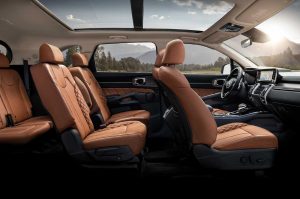
But the Sorento offers room for seven seats in a compact-sized package, which the others don’t. It also offers a standard and much stronger optional engine, which the Tiggy and Outlander also don’t.
Prices start at $29,390 for the base LX trim with a 2.5 liter engine, eight speed automatic transmission and front wheel drive. With the optional AWD system, this version stickers for $31,190.
The EX comes with a much stronger turbocharged version of the 2.5 liter engine, paired with a faster-shifting eight-speed dual clutch automatic transmission. Unusually – for the class and in general – the Sorento’s strongest engines is not also-automatically paired with all-wheel-drive.
You can go either way. And with either engine.
The FWD EX stickers for $34,990. With the optional AWD system, the price is $36,790.
Even the top-of-the-line SX (which also comes standard with the more powerful version of the 2.5 liter engine) gives you the choice to go FWD or AWD.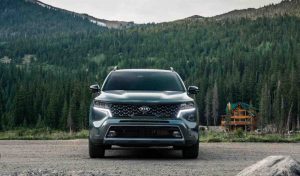
With AWD – and the Prestige X-Line equipment, which includes a configurable LCD gauge cluster and a 12-speaker Bose premium audio system – the MSRP is $42,590.
What’s New
The Sorento gets a major makeover, stylistically as well as functionally. It looks more like a traditional SUV now than a smaller-scale version of the Sedona, Kia’s seven passenger (and full-size) minivan.
Its third row also has more room (and access) than previously.
And much more so than rivals like the VW Tiguan.
It also has two new engines and a plethora of high-end-ish features such as a full-flatscreen main gauge cluster in the SX trim.
What’s Good
You don’t have to buy the optional engine to get AWD.
If you buy the optional engine, you don’t have to buy AWD.
A useable rather then merely visual third row.
What’s Not So Good
The formerly available V6 is no longer available.
It’s expensive vs. the Tiguan (which stickers for $25,245 to start).
Automatic stop/start is standard.
Last year, the Sorento was available with a base 2.4 liter four cylinder engine and an optional 3.3 liter V6 engine. Now it is available with a new 2.5 liter four cylinder engine.
With – or without – a turbocharger.
The one without makes 191 horsepower – an uptick over the previous Sorento’s base 2.4 liter four, which made 185 horsepower. It also makes slightly more power than the VW Tiguan’s standard – and only available – 2.0 liter, 184 hp turbocharged four cylinder engine.
And the forthcoming (2022) Mitsubishi Outlander’s Nissan-sourced and only-available 2.5 liter, 181 hp engine.
Kia offers the new standard engine with – or without – AWD.
The optional engine is a turbocharged version of the 2.5 liter engine, which makes 281 horsepower – slightly less horsepower than the previously available 290 hp 3.3 liter V6. But the torque output is way up – to 311 ft.-lbs. vs. 252 ft.-lbs. for the V6. And it’s available much lower in the powerband – at 1,700 RPM vs. 5,300 RPM previously.
Why the switch from the V6 to the turbo four? Because of an acronym. Two of them, actually.
MPGs – and CAFE.
Both amount to the same thing. The federal government lays down mandatory minimum miles-per-gallon standards that all car companies must comply with; the compliance part is calculated using corporate average fuel economy numbers – a bureaucratic formula for the sum total/average MPGs achieved (or not) by a given car company’s lineup of vehicles. A V6 that averages say 28 MPG vs. a four that averages say 30 has the same effect on the CAFE average as a B or a C has on a grade point average.
This is why V6s are disappearing and being replaced by turbocharged fours, which can approximate the power output of the V6s they replaced while scoring slightly better on government MPG tests.
Italicized to emphasize the point.
The previous Sorento’s 3.3 liter V6 rated 20 city, 29 highway. The new Sorento’s turbo four rates 22 city, 29 highway.
What’s the upside – for the buyer?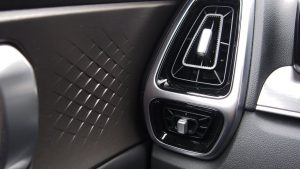
These turbocharged fours feel much stronger than the V6s they’re replacing – because of their higher torque output at lower engine RPM. You get the same – or better – thrust with the pedal halfway rather than all-the-way to the floor.
But it’s not any quicker than it was before, with the V6. The new Sorento with the turbo four gets to 60 in about 7.4-7.5 seconds, depending on the drive configuration. The previous Sorento V6 made it to 60 in about the same timeframe.
The thing to bear in mind here is that the turbo four maintains the performance the government regs are trying to take away. So don’t focus on the trivial mileage difference; be grateful there’s no performance deficit.
Also, the new Sorento’s performance exceeds that of the performance available in immediate cross-shops like the VW Tiguan, which takes about 8.3 seconds to get to 60.
The Sorento’s 2,000 pound maximum capacity is the one thing that’s the same as last year.
Size matters.
Most crossovers that seat seven realistically are substantially bigger than the Sorento. They are mid-sized or even bigger – and so take up more room in the garage – and on the road.
They are more to deal with.
Which sets up a conundrum for those who need the extra room but don’t want to deal with the extra size. The having to pull in partially, then back it up and straighten out, then forward again, once you finally have it lined up straight. And then the same kabuki, in reverse – when you’re backing out of a tight spot.
This seven-passenger crossover is as easy to maneuver as as a five-passenger compact-sized car – because it has about the same-sized footprint.
Which is the whole point of the exercise.
Something big enough – but not too big.
And – not weak.
As mentioned above, others with about the same footprint that seat seven visually haven’t got much guts. I like the VW Tiggy a lot – but I liked it a lot better when it was available with a TDI diesel engine (and a manual transmission) and had more guts than the current under-engined and automatic-only Tiggy.
VW gave in to the government. Kia end-ran around the government.
The Sorento may not have a V6 anymore (neither do other small crossovers that only seat five, like the Toyota RV4, which also used to offer one) but adding a turbo to the four makes up for the loss of cylinders.
It also makes it easier – or rather, seem like it is.
The old V6 had the power – but you had to make it work to get it. Torque – and horsepower – peaks way up there in the powerband. That meant revving it, which meant flooring it. With the turbo four, you have diesel-like torque under your right foot, right now. The engine feels less stressed – which is ironic in a way because it is under more pressure.
Literally. That’s what turbo (and super) charging does.
Whether that increased pressure will mean decreased longevity vs. the V6 is something only time will tell.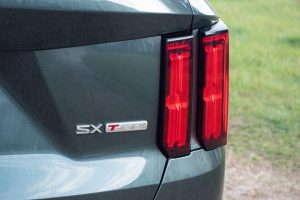
You may have read other reviewers criticize the eight-speed dual-clutch automatic that is paired with this engine; the main complaint being that its shifting is too aggressively firm and noticeable for a family-ish vehicle like the Sorento.
But that view depends on what you like. It is true that the Kia’s dual clutch transmission feels more aggressive; I liked that. I prefer that to the disconnected feel of CVT transmissions that don’t shift at all and – under pedal-to-the-floor acceleration – run the engine to near redline and hold it there until you let the pedal up.
The Kia may not have a V6 but it is one of a dwindling number of small crossovers that doesn’t come with a CVT automatic.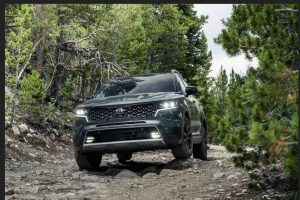
It does, however, have ASS – automated stop-start “technology.” So the engine cuts off when the Sorento stops moving – then cuts on again, when you push on the gas pedal, to get going. The on-offs are noticeable and for that reason it’s nice that there is an Off button.
ASS is another “feature” brought to you by government – not Kia. Or any other car manufacturer. It is manufactured by regulations – see the business about MPGs and CAFE up above. Shutting the engine off as often as possible can squeeze out an extra .5 MPGs – and you’d better believe that matters to every car company, in terms of complying with the MPG and CAFE regs.
Another thing this Kia has is a semi-self-driving feature, styled steering assist that’s a bit more sophisticated than the common lane keep assist systems that warn you – usually with a beep – when you wander a bit too far to the left or the right (as interpreted by sensors that scan and follow the painted lines on either side, triggering the beep if a tire touches a painted line). This one turns the wheel – via an electric motor connected to the steering system – to keep you in your lane.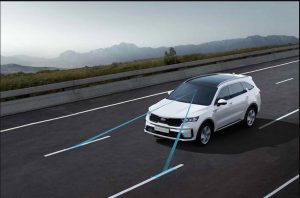
It’s also meant to make steering easier, though some may not like the feel of the assistance (that’s me) in which case, simply turn the system off. There is also a new feature, at least it was new to me. If you’re sitting in traffic and the car ahead moves forward but you don’t, a prompt will . . . prompt you to stop daydreaming and start driving.
It’s also nice that Kia lets you buy the stronger engine without forcing you to reign it in with all-wheel-drive. The same reviewers who didn’t like the “aggressive” shifting of the eight-speed dual clutch transmission also complain about the turbo engine overcoming the available traction of just the front wheels.
Heaven forbid you might chirp the tires. It might result in a smile.
These killjoys are in the wrong line of work.
Maybe they ought to be reviewing toasters.
The new Sorento looks very much unlike the previous Sorento . . . which looked very much like the Sedona minivan.
Not that there’s anything wrong with that.
This one looks more like the Telluride, Kia’s newest (and largest) crossover SUV.
Just downscaled.
Third row seating is standard but you can choose a second row bench or captain’s chairs and seats for six or seven. The third row is a squeeze – to get back there – but once you’re there, it’s viable seating for teenagers and doable short-hop seating for most adults, with just shy of 30 inches of room for your legs.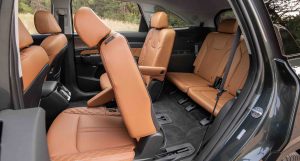
Kia provides a one-touch slide/tilt function for the second row chairs – to get them out of the way for people trying to make their way to the third row seats – but I found it easier to walk around the second row – if you have captain’s chairs – and walk (well, scrabble) down the aisle to the third row.
In the first row, it’s easy to believe you’re in first class. In the SX Prestige trim, which has that configurable (multiple screens you can toggle through) LCD main gauge cluster, with another huge (10.25 inch) LCD touchscreen off to its right. Look up – at the panorama sunroof that stretches from the first row to the third row. Look down and to your side – at the pleated/ventilated/heated mocha (my test ride) leather seats and door panels. Close your eyes – and listen to the 12 speaker Bose surround sound audio system.
These are features you used to have to spend Mercedes or BMW money to get – which you can now get in a Kia that costs half what the Benz or BMW with the same features cost just three or four years ago.
I wrote about this “meeting in the middle” a few weeks ago; about how there’s getting to be less and less difference, in terms of features and amenities, between a family-priced vehicle like this Sorento and a luxury-badged vehicle like a Benz or a BMW.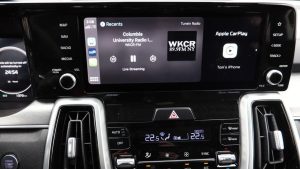
It makes things easier on people who can’t afford the luxury-badged stuff; and harder on the people trying to sell the luxury-badged (and priced) stuff.
The Rest
Even with its third row in place, the Sorento has almost 13 cubic feet of “trunk” space behind them, about as much as the typical mid-sized sedan has in its actual trunk. With the second and third rows folded, it has 75.5 cubic feet of cargo capacity, several times as much as any full-sized sedan and more than its main cross-shop, the VW Tiguan (which tops out at 65.7 cubic feet) and very competitive with the cargo space available in larger/mid-sized crossovers.
Kia also thoughtfully places USB ports throughout the Sorento – including three in the third row of the SX I tested. However, you’ve got to look for the 12 volt power point, which is installed on the back of the center console, facing the second row. Make sure your radar detector has a long enough cord!
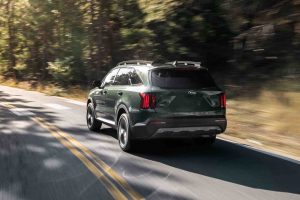 The main deficit here – relative to the Tiguan and probably also the new Outlander (it’s not out yet, so prices haven’t been published) is the Kia’s higher . . . price. A base Tiggy stickers for just over $25k while the base Sorento stickers just under $30k.
The main deficit here – relative to the Tiguan and probably also the new Outlander (it’s not out yet, so prices haven’t been published) is the Kia’s higher . . . price. A base Tiggy stickers for just over $25k while the base Sorento stickers just under $30k.
But then, you get what you pay for.
And sometimes, more.
No matter how much you spend on a Tiggy, it’ll never has as much room – or guts – as this Sorento. And because it does have room – ands guts – it can be cross-shopped against mid-sized/three-row crossovers that cost a lot more and are a lot more, too.
To deal with. And to buy.
The Bottom Line
Making it fit without making it too big – or too tight – is no easy thing to do.
The Sorento shows how it’s done.
. . .
Got a question about cars, Libertarian politics – or anything else? Click on the “ask Eric” link and send ’em in!
If you like what you’ve found here please consider supporting EPautos.
We depend on you to keep the wheels turning!
Our donate button is here.
If you prefer not to use PayPal, our mailing address is:
EPautos
721 Hummingbird Lane SE
Copper Hill, VA 24079
PS: Get an EPautos magnet or sticker or coaster in return for a $20 or more one-time donation or a $10 or more monthly recurring donation. (Please be sure to tell us you want a magnet or sticker or coaster – and also, provide an address, so we know where to mail the thing!)
My eBook about car buying (new and used) is also available for your favorite price – free! Click here. If that fails, email me at [email protected] and I will send you a copy directly!


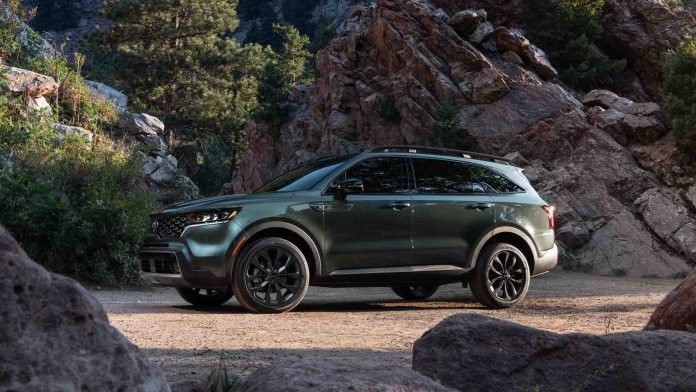

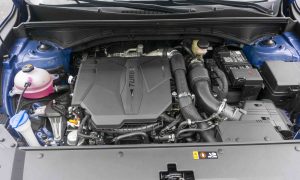
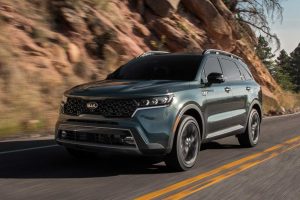
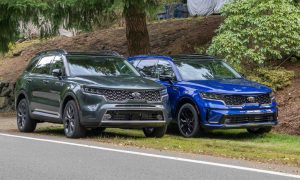







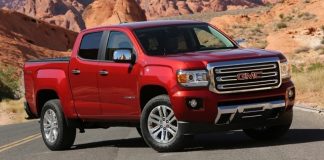
How is the idle, in gear, on these 4 cylinder auto trans cars? At least a properly designed V6 still has a smooth idle, any 4 banger automatic trans I’ve driven can’t match the smooth idle of a modern V6 or god bless them, an American V8. Kid’s Mazda 6, 2015, 4 cyl. has an ok but not totally smooth idle.
Hi Sparkey,
The ones I have test driven – which is many – idle quite smoothly. The issue they all have – and it’s not just the fours – is that the engine cuts off and on and off and on… over and over and over. This is “auto stop-start” – aka ASS – and it’s all-but-unavoidable in new cars, irrespective of engine.
Can you “configure” the assist features and start/stop to stay off, or is it a reset each time you start the car? My 2018 Grand Cherokee at least has a dedicated button fo A S S, but it resets each time the ignition is turned off, annoying. Worse was the rental VW SUV in Europe, no dedicated button it was scroll and select each time via multifunction steering wheel buttons, also to turn off the very annoying lane assist which was a constant steering bump on narrow roads in Der Fatherland. Also would bump the wheel when passing trucks, nice.
And my forever question, how’s the seat comfort? You should have a comfy baseline from your real seats in the TransAm!
My SIL just bought a new Kia. She said she’d always wanted a sunroof, the worst possible option you can have in Texas. The price was driven up by thousands of dollars to get something only good for destroying a car in Texas.
But each to their own. I saw a conversation between two young men(30’s)yesterday. One said he’d just made an investment of $50,000 and in a year it will be worth $40,000 or less and in 5 years it will be worth $10,000. The other guy said that was insane. Why would you make an investment like that. The first guy said “I bought a new car”. Then he came clean and said he would never buy a new car but was just making a point.
My renter just paid $85,000 for a new 2020 Chevy crew cab dually diesel pickup. No doubt a 21 is at least another $10,000. Another friend said he had a friend who’d just bought a new Ford pickup for $105,000. A 450 Ford sells for another $40,000 above that. Insanity for any new car but at least this Kia didn’t quite break $30,000….as a stripper(or as close as you can get).
There’s so much insanity in buying new I can’t imagine wasting the money on a new truck. A friend bought a new 2020 Ford crewcab diesel 350 a couple years ago. It has two backup cams. He bought a new work bed for it but before he could put it on, he spoke with a friend who bought the same pickup and installed a work bed. He put the backup cams into the same place as they were on the factory bed. It wouldn’t run. He was scratching his head months later. So now I know 3 people with new Ford pickups who can’t do what they bought them for since they have no use for a factory bed. The automotive industry must have Biden running it.
I just checked the price of used diesel pickups. Same price as new. Someone has lost their mind.
KIA has come a long way from when I first saw them in the US.
Makes it hard for me to accept that price, since I still consider them “cheap” foreign transport.
this article is another sad reminder that if realistic people don’t take control, all our cars are going to be running on dual turbo lawnmower engines soon.